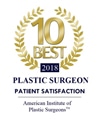Also known as otoplasty, this surgical procedure is used to reduce large or protruding ears. This procedure sets the ears back closer to the head and may involve molding, shaping or removing cartilage in order to pull the ears in and reduce the protrusion. Ear reduction surgery will not affect your hearing since it involves only the outer ear, not the middle or inner ear where hearing takes place.
Candidates must be in good health, have no active diseases or serious, pre-existing medical conditions, and must have realistic expectations of the outcome of the surgery. Otoplasty can be performed at any age after the ears have reached (or nearly reached) their adult size. This usually occurs at around 5 to 6 years of age. Ear reduction surgery is most frequently performed on children between the ages of 4 and 14. Most procedures are performed for aesthetic reasons and to help children better adapt and blend in with their peers. In many cases, children with large ears suffer from ridicule, adapt poorly to school, and feel extremely self-conscious. Adults may be candidates for this operation as well. Dr. Roesner will be able to determine whether or not you are a good candidate during a consultation.
NOTE: You may not be a candidate for surgery if you smoke, have recently quit smoking, or if you are exposed to second-hand smoke. Primary and secondary smoking decreases blood flow to the body’s tissues. This can result in prolonged wound healing, skin loss, infection, increased scarring, and a number of other complications depending on the kind of procedure performed. Click here for more information related to smoking.
An incision is made behind the ear, where the ear is joined to the head. The surgeon then removes as much of the cartilage and skin as needed to achieve the desired effect. The surgeon may trim the cartilage, reshaping it and then pinning it back with sutures to secure the cartilage. In other instances, the surgeon will not remove any cartilage at all, but may simply use stitches to reshape the cartilage. Incisions and the resulting scars are well concealed on the back of the ear.
The majority of these procedures are completed on an out-patient basis. Dr. Roesner has surgical privileges at North Suburban Medical Center, Rose Medical Center as well as St. Anthony Hospital.
General anesthetic is used so that you will sleep and remain comfortable throughout the procedure. Local anesthesia with intravenous sedation is also an option for some patients.
It is very important that you follow post-operative instructions. This will promote healing and improve progress towards your new physical appearance. Also, it is important that you attend all scheduled follow-up appointments so that your surgeon can assess your long-term results and answer any questions or concerns you may have.





I had the Laser Genesis treatment. The procedure was comfortable on my skin and without any downtime for noticeable results! I would highly recommend this procedure. The entire office is great to work with and an awesome team. L.T., Lafayette
Amazing staff , ready to answer all my questions , I felt very comfortable talking to them ,specially Leah , she made feel very secure about the procedures and totally happy of have chosen them. Zuleyma F.
Fantastic! I have had multiple procedures done by almost everyone in the office . I recommend this place to everyone! Love this place! Lindsay W.
